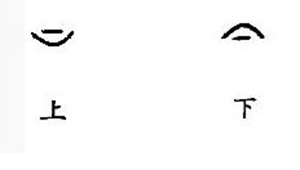Four main types of Chinese characters

Chinese characters have been used for about 3300 years, and the earliest Chinese characters were oracle bone inscription. Before New China was founded in 1949 people used traditional characters, but after that people started to try to make traditional Chinese characters easier and more convenient to use and learn, so they invented simplified Chinese characters which have been used in the mainland up to now. But traditional Chinese characters are still being used in Hong Kong and Taiwan at present.
Before you learn Chinese characters, you need to know the six categories of Chinese characters: pictographs, pictophonetic characters, associative compounds, self-explanatory characters, phonetic loan characters, and mutually explanatory characters. Here we only introduce the common four categories, because the other two categories are unusual.
1. Pictographs
Some Chinese characters were created from pictures of real things,
like “kǒu 口 mouth.”

“mǎ 马 horse”

“mén 门 door”

“mù 木 tree”

You can see that some simplified Chinese characters are still the same as traditional Chinese characters.
2. Pictophonetic characters
Pictophonetic characters are always made from a radical and a single Chinese character.
Pictophonetic characters can be divided into 8 types. The most common type is “left radical right phonetic.” The left part of the Chinese character is a radical; it shows you the possible meaning this Chinese character might be related to, and from the right part, you can guess how to read this Chinese character.
Like “ma 吗 a question word”
The left part is a radical, “kǒu 口 mouth;” you need to ask questions by mouth, so the left part shows you the possible meaning, and the pronunciation of the right part “mǎ 马 horse” is similar with “ma 吗 a question word.” So “吗” is the meaning side “口” plus the phonetic side “马.”
“mā 妈 mother”
The left side is a radical, “nǚ 女 female” shows the meaning; the right side shows the phonetic, because “mǎ 马 horse” and “mā 妈 mother” have similar pronunciations.
The other types are “right radical left phonetic,” “up radical down phonetic,” “down radical up phonetic,” “outside radical inside phonetic,” “inside radical outside phonetic,” and so on.
3. Associative compounds
These Chinese characters can be divided into two parts: One part is about figure, the other part is about meaning.
For example in “xiū 休 rest,” the left part is the radical of person, the right part means tree; it’s like a man leans against the tree. In ancient times, people worked in the field, and when they felt tired, they could have a rest beside a tree. When you see this Chinese character, you can think of this figure naturally.
“dàn 旦 daybreak, dawn,” can also show you a figure. The upper part is“rì 日 the sun,” and the lower part is like the horizon line; when the sun rises from the horizon line it’s daybreak.
“nán 男 male, man, ” can be understood by the meaning. The upper part is “tián 田 farm field, ” the lower part is “lì 力 strength,” for people who work in the field with strength are just men.
4. Self-explanatory characters
These types of Chinese characters are not convenient to be drawn as a concrete image, so they are shown by a single abstract symbol, line, or a Pictograph and an abstract symbol.
For example “yī 一 one,” “èr 二 two,” “sān 三 three,” one line represents the number “one,” two abstract lines are just the abstract image of two things, and so is three.
“shàng 上 on, up,” the short line shows the position; it’s up the long line “xià 下down, below,”the short line is below the long line.

Like “xiōng 凶 deadly trap ”

We have six categories, but not every Chinese character can be classified into a certain category, because they have experienced a long-term process of evolution. However, knowing the principles of making Chinese characters can help you memorize more easily and make it fun.







